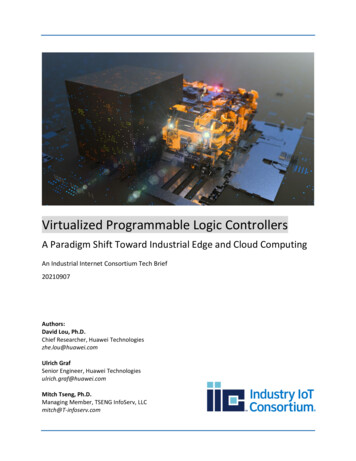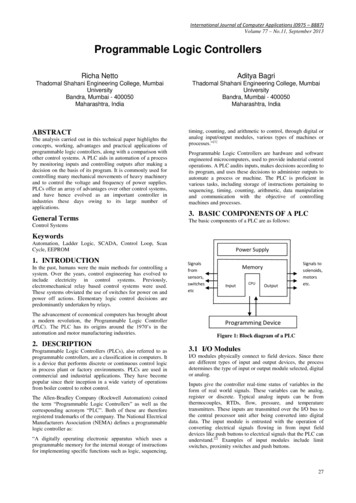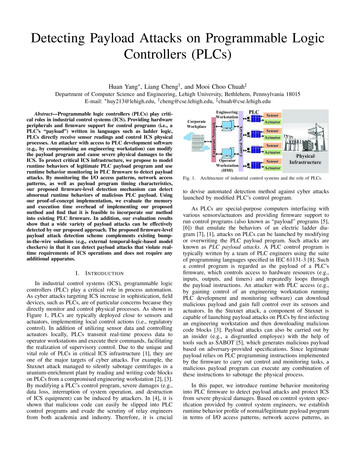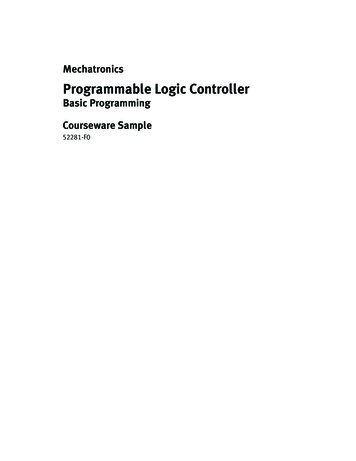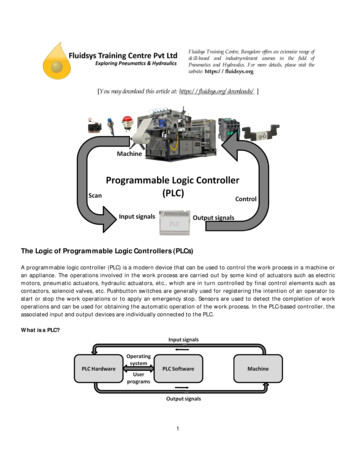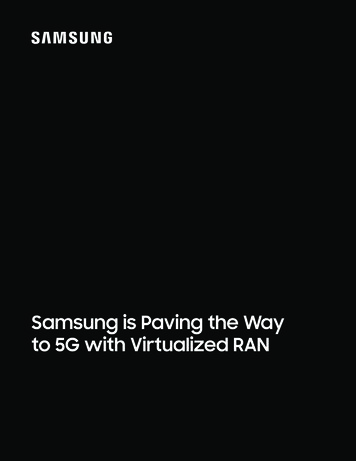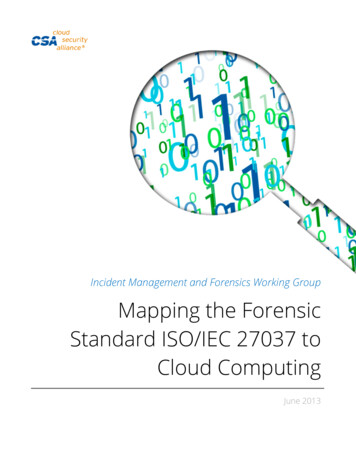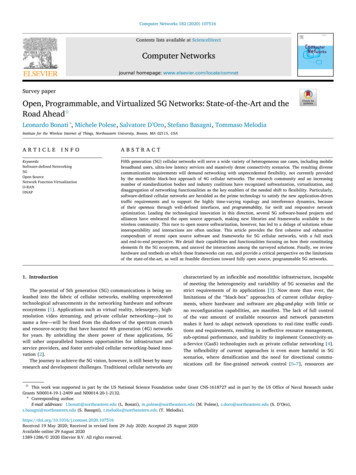
Transcription
Computer Networks 182 (2020) 107516Contents lists available at ScienceDirectComputer Networksjournal homepage: www.elsevier.com/locate/comnetSurvey paperOpen, Programmable, and Virtualized 5G Networks: State-of-the-Art and theRoad Ahead Leonardo Bonati , Michele Polese, Salvatore D’Oro, Stefano Basagni, Tommaso MelodiaInstitute for the Wireless Internet of Things, Northeastern University, Boston, MA 02115, USAARTICLEINFOKeywords:Software-defined Networking5GOpen SourceNetwork Function VirtualizationO-RANONAPABSTRACTFifth generation (5G) cellular networks will serve a wide variety of heterogeneous use cases, including mobilebroadband users, ultra-low latency services and massively dense connectivity scenarios. The resulting diversecommunication requirements will demand networking with unprecedented flexibility, not currently providedby the monolithic black-box approach of 4G cellular networks. The research community and an increasingnumber of standardization bodies and industry coalitions have recognized softwarization, virtualization, anddisaggregation of networking functionalities as the key enablers of the needed shift to flexibility. Particularly,software-defined cellular networks are heralded as the prime technology to satisfy the new application-driventraffic requirements and to support the highly time-varying topology and interference dynamics, becauseof their openness through well-defined interfaces, and programmability, for swift and responsive networkoptimization. Leading the technological innovation in this direction, several 5G software-based projects andalliances have embraced the open source approach, making new libraries and frameworks available to thewireless community. This race to open source softwarization, however, has led to a deluge of solutions whoseinteroperability and interactions are often unclear. This article provides the first cohesive and exhaustivecompendium of recent open source software and frameworks for 5G cellular networks, with a full stackand end-to-end perspective. We detail their capabilities and functionalities focusing on how their constitutingelements fit the 5G ecosystem, and unravel the interactions among the surveyed solutions. Finally, we reviewhardware and testbeds on which these frameworks can run, and provide a critical perspective on the limitationsof the state-of-the-art, as well as feasible directions toward fully open source, programmable 5G networks.1. IntroductionThe potential of 5th generation (5G) communications is being unleashed into the fabric of cellular networks, enabling unprecedentedtechnological advancements in the networking hardware and softwareecosystems [1]. Applications such as virtual reality, telesurgery, highresolution video streaming, and private cellular networking—just toname a few—will be freed from the shadows of the spectrum crunchand resource-scarcity that have haunted 4th generation (4G) networksfor years. By unbridling the sheer power of these applications, 5Gwill usher unparalleled business opportunities for infrastructure andservice providers, and foster unrivaled cellular networking-based innovation [2].The journey to achieve the 5G vision, however, is still beset by manyresearch and development challenges. Traditional cellular networks arecharacterized by an inflexible and monolithic infrastructure, incapableof meeting the heterogeneity and variability of 5G scenarios and thestrict requirements of its applications [3]. Now more than ever, thelimitations of the ‘‘black-box’’ approaches of current cellular deployments, where hardware and software are plug-and-play with little orno reconfiguration capabilities, are manifest. The lack of full controlof the vast amount of available resources and network parametersmakes it hard to adapt network operations to real-time traffic conditions and requirements, resulting in ineffective resource management,sub-optimal performance, and inability to implement Connectivity-asa-Service (CaaS) technologies such as private cellular networking [4].The inflexibility of current approaches is even more harmful in 5Gscenarios, where densification and the need for directional communications call for fine-grained network control [5–7], resources are This work was supported in part by the US National Science Foundation under Grant CNS-1618727 and in part by the US Office of Naval Research underGrants N00014-19-1-2409 and N00014-20-1-2132. Corresponding author.E-mail addresses: l.bonati@northeastern.edu (L. Bonati), m.polese@northeastern.edu (M. Polese), s.doro@northeastern.edu (S. D’Oro),s.basagni@northeastern.edu (S. Basagni), t.melodia@northeastern.edu (T. 516Received 19 May 2020; Received in revised form 29 July 2020; Accepted 25 August 2020Available online 29 August 20201389-1286/ 2020 Elsevier B.V. All rights reserved.
Computer Networks 182 (2020) 107516L. Bonati et al.Fig. 1. The main building blocks of open source, programmable and virtualized 5G networks with their components and technologies.scarce and spectrum availability and energy consumption are strictlyregulated [8].Both industry and academia now agree that the practical realizationof 5G systems needs a radical overhaul of all plug-and-play approachesin favor of new, agile and open paradigms for network deployment,control and management. In this context, revolutionary and innovativenetworking solutions based upon programmability, openness, resourcesharing and edgefication are welcome to the cellular arena [9,10]. Newnetworking principles such as SDN [11], network virtualization [12],and Multi-access Edge Computing (MEC) [13] have demonstrated thatdynamic network control and agile management (e.g., frequency planning, user scheduling, mobility management, among others) is possible.Similarly, the emergence of network slicing and cloud Radio AccessNetwork (RAN) technologies have made it clear that infrastructuresharing not only maximizes resource utilization, but also opens newmarket opportunities (e.g., differentiated services, infrastructure leasing, CaaS), thus representing a desirable solution for network operators andinfrastructure providers alike [14,15].Following the growing interest in softwarization and virtualizationtechnologies, the 5G ecosystem has witnessed the exponential growthof dedicated solutions for 5G applications [16]. These solutions includesoftware and hardware tailored to specific tasks [17] and full-fledgedmultitasking frameworks spanning the whole infrastructure [18]. Despite their diversity in structure and purpose, the majority of thesesolutions has two important aspects in common: They are open sourceand fully programmable. These two aspects together are bringing unprecedented flexibility to 5G systems, making them accessible to a much broadercommunity of researchers and developers.Just a few years ago, the majority of researchers had no accessto actual cellular networks. When they did, access was limited toindividual network components or functionalities. Today, the softwaredefined paradigm as made popular by the GNU Radio libraries [19],has been easily adopted by software bundles such as OpenAirInterface(OAI) [17] and srsLTE [20] for swift instantiation of fully-functionalcellular networks on commercial Software-defined Radio (SDR) devices. Software frameworks such as O-RAN [21,22], which run on‘‘white-box’’ servers, allow reconfiguration and optimization of networkand transceiver functionalities. These new software and hardware components have radically changed the way the research community andthe telecom industry plan, deploy, and interact with cellular systems.Prototyping, testing, and deploying new algorithms and protocols forcellular networks enjoys now unprecedented ease and time to market.The advantage of this revolutionary approach is twofold: (i) Opennessallows researchers to evaluate and analyze their solutions on a realworld setup [23], and enables telecom operators to directly interact andcontrol networking equipment [4]. Also, (ii) programmability fosters thedesign of novel and advanced algorithms that optimize network performance by efficiently and dynamically allocating network resources andcontrolling software and hardware functionalities, even in real time,if appropriate. For instance, telecom operators such as Rakuten areleveraging microservices to separate the user and control planes in theirnetwork deployments, thus endowing them with unprecedented flexibility [24]. Programs like Platforms for Advanced Wireless Research(PAWR) by the U.S. National Science Foundation [25], are bringingprogrammable wireless testing infrastructure at scale to broad communities of researchers—thus creating a fertile ground for software-basedopen innovation.The race to the open source and programmable Holy Grail hasgenerated a plethora of heterogeneous software and hardware components and frameworks, whose functionality, scope, and interoperabilitywith other solutions are often obscure and hard to assess. This articleorganizes the multiplicity of solutions into the appropriate building blocks ofthe open source and programmable 5G ecosystem. We detail how each components fits into a 5G network, highlight the interactions among solutions,and unfold their capabilities and functionalities, highlighting strengths andlimitations. Our survey provides the first cohesive and exhaustive recountand taxonomy of open, programmable, and virtualized solutions for 5Gnetworks. As most frameworks and devices serve specific purposesin the 5G architectures, we also provide usage directives and howto guidelines to combine different components into full-fledged opensource 5G systems.With respect to previous survey efforts [26,27] we provide extensive details and commentary on the architecture of softwarized 5Gnetworks, their building blocks, the software frameworks developed sofar, and their interactions.Fig. 1 provides a visual guide to how the topics surveyed in ourwork relate to one another, as well as to the structure of the remainderof this article.Section 2 provides a bird’s-eye view of the architecture of 5Gsystems, describing its components and technologies. Sections 3 and4 introduce and describe open source solutions for the RAN and CNportions of the infrastructure, respectively. General open source frameworks inclusive of both RAN and CN functionalities are discussed inSection 5. Virtualization and management frameworks are providedin details in Section 6. Section 7 describes software-defined hardwareplatforms for open source radio units, highlighting their features andtheir suitability for 5G applications. Section 8 presents a variety ofexperimental testbeds allowing instantiation of softwarized 5G networks and testing of new solutions. Finally, in Section 9 we concludethis article by identifying limitations of the current 5G open sourceecosystem and discuss the road ahead, with its unanswered researchquestions. A list of acronyms used throughout the article is provided inthe Appendix.2
Computer Networks 182 (2020) 107516L. Bonati et al.Fig. 2. Cellular network architecture.Core (EPC) and 5G Core (5GC) for the CN, respectively.2 Fig. 2 highlights the differences, in terms of flexibility, between the deploymentsof 4G (in the yellow boxes) and 5G (in the orange boxes) networks.For the CN, the 4G EPC has multiple components that have beentraditionally executed on dedicated hardware, and only recently havetransitioned to software-based deployments. The 5GC, instead, has beendesigned according to a service-based approach from the get-go. TheEPC servers are split into multiple virtual network functions providingspecific functionalities. They are connected to each other through openand standardized interfaces. A similar separation principle has beenconsidered for the 5G RAN, now designed to provide a functionalsplit among heterogeneous parts of the base stations (e.g., control,computing and radio units), with different layers of the protocol stackinstantiated on different elements located in different parts of thenetwork.2. Architectural enablers of 5G cellular networksMobile networks are transitioning from monolithic architectures,based on dedicated ‘‘black-box’’ hardware with proprietary firmwareand software, to disaggregated deployments based on open source software that runs on generic SDR or ‘‘agnostic’’ computing devices [28–30]. This trend is not new to cellular networking, as it has been partof the general discussion around 4G cellular networks. However, whilesoftware-based design represents a relatively recent evolution in thecontext of 4G networks, 5G specifications have foreseen the flexibledeployment of agile, softwarized services already in their early stages,with their application to key infrastructure components such as thecore, the RAN and the edge cloud [31]. This ‘‘flexibility-by-design’’puts 5G networks in the privileged position to meet the requirementsof heterogeneous traffic classes, mobility and advanced applicationsthrough design that is unified, open and dynamically changeable.In this section we provide an overview of 4G and 5G cellularnetwork architectures, as well as their main components and buildingblocks (Fig. 1). We start by describing radio access and core networkelements and general deployment paradigms. We then discuss thearchitectural and technology enablers such as Software-defined Networking (SDN), NFV, network slicing, MEC, and intelligent networks.Our aim is to provide a reference architecture to map the different opensource software libraries and frameworks surveyed in this article tospecific network functionalities.LTE and EPC. The LTE RAN is composed of evolved Node Bases(eNBs), i.e., the LTE base stations, which provide wireless connectivityto the mobile User Equipments (UEs). The eNBs are generally deployedas a single piece of equipment on dedicated hardware components, andare networked together and to the core network. LTE operates on aframe structure with 10 subframes of 1 ms per frame, and 12 to 14OFDM symbols for each subframe. The maximum carrier bandwidth is20 MHz. Up to 5 carriers can be aggregated for a total of 100 MHz [34].The LTE protocol stack for the user plane (also known as EvolvedUniversal Terrestrial Access Network (E-UTRAN), bottom right cornerof the RAN box in Fig. 2) consists of:2.1. Architecture of 4G and 5G cellular networksFig. 2 provides a high-level overview of the 4G and 5G cellulararchitectures, along with some of the open source software frameworksenvisioned as their components.Cellular networks consist of a Radio Access Network (RAN) anda Core Network (CN). Even though this separation remains unalteredin 4G and 5G deployments, the actual implementation and configuration of these core components differ greatly. Particularly, they complywith the 3rd Generation Partnership Project (3GPP) Long Term Evolution (LTE) and NR1 specifications for the RAN, and the Evolved Packet The Packet Data Convergence Protocol (PDCP) layer, which implements security functionalities (e.g., ciphering of packets), performs header compression, and takes care of the end-to-endpacket delivery between the eNB and the UE [35]. The Radio Link Control (RLC) layer, which provides data linklayer services (e.g., error correction, packet fragmentation andreconstruction).It supports three different configurations:The Transparent Mode (TM), to simply relay packets between theMedium Access Control (MAC) and PDCP layers;1Although initially introduced as ‘‘New Radio’’ in [32], NR has lost itsoriginal meaning in the latest 3GPP specifications [31] where it now refers tothe 5G RAN.2Notice that, while LTE has been originally associated with 4G networks,its evolution (e.g., LTE-A) will be part of the air interface of 5G networks,together with NR [33].3
Computer Networks 182 (2020) 107516L. Bonati et al.The 5G Core. Openness and flexibility have guides the design ofthe 5GC, now realized according to a service-based approach [50].Control and user plane core functionalities have been split into multiple network functions [51]. The 3GPP has also defined interfacesand Application Programming Interfaces (APIs) among the networkfunctions, which can be instantiated on the fly, enabling elastic network deployments and network slicing (Section 2.3). The User PlaneFunction (UPF) is a user plane gateway to the public Internet thatacts as mobility anchor and QoS classifier for the incoming flows.On the control plane side, most of the MME functions (e.g., mobilitymanagement) are assigned to the Access and Mobility ManagementFunction (AMF). The Session Management Function (SMF) allocates IPaddresses to the UEs, and orchestrates user plane services, includingthe selection of which UPF a UE should use. For a detailed overview ofall 5G core functions the reader is referred to [50,52].the Unacknowledged Mode (UM), for buffering, segmentation,concatenation and reordering, and the Acknowledged Mode (AM),for retransmitting packets via a ACK/NACK feedback loop [36]. The MAC layer, which performs scheduling, interacts with RLC tosignal transmissions, forwards the transport blocks to the physicallayer, and performs retransmissions via Hybrid Automatic RepeatreQuest (HARQ) [37]. The Physical (PHY) layer, which takes care of channel coding,modulates the signal, and performs transmissions in an OFDMbased frame structure [38].These layers also perform control plane functionalities, which concern measurement collection and channel quality estimation. Additionally, the Radio Resource Control (RRC) layer manages the life cycle ofthe eNB to UE connection, and it is a point of contact with the corenetwork for control functionalities.The main components of the EPC (in the top right corner of Fig. 2)are: (i) The Packet Gateway (PGW) and Service Gateway (SGW), whichare packet gateways to and from the Internet; (ii) the Mobility Management Entity (MME), which handles handovers and the UE connection life cycle from the core network point of view, and (iii) theHome Subscription Server (HSS), which manages subscriptions andbilling [39].2.2. Enabling technologies for softwarized 5G cellular networks5G networks will embody heterogeneous network components andtechnologies to provide unprecedented performance levels and a uniqueexperience to subscribers. Managing the integration of such amenagerie of technologies, controlling such variegate infrastructureand orchestrating network services and functionalities is clearly no trivial feat. To solve this management and control problem, 5G networkshave borrowed widespread and well-established processes and architectures from the cloud-computing ecosystem, where softwarization andvirtualization are merged together to abstract services and functionalities from the hardware where they are executed. In the following, weintroduce two of these technologies and how they integrate with future5G systems.NR. The 3GPP NR RAN represents quite the evolution of the 4G LTE,especially in terms of protocol stack, functionalities and capabilities.First, it supports a wider range of carrier frequencies, which includepart of the millimeter wave (mmWave) spectrum [40]. Second, theframe structure, while still OFDM-based, is more flexible, with a variable number of symbols per subframe, the option to use much largerbandwidths than LTE (up to 400 MHz per carrier), and the integration of signals and procedures to manage directional transmissions atmmWaves [41]. Third, the 5G RAN can be connected either to the4G EPC (non-standalone configuration) or to the new 5GC (standaloneconfiguration). Finally, the NR base stations (Next Generation NodeBases (gNBs)) allows distributed deployment, with different parts of theprotocol stack in different hardware components.The NR protocol stack (bottom left corner of Fig. 2) features a newlayer on top of the PDCP, i.e., the Service Data Adaptation Protocol(SDAP) layer [42], which manages the QoS of end-to-end flows, andmaps them to local resources in the gNB-UE link. The design of theremaining layers has been updated to support the aforementioned NRfeatures [43–47].Softwarization and software-defined networking . In order to integrate hardware components produced by multiple vendors with different functionalities and configuration parameters, 5G systems relyon softwarization. This technology concept grew in popularity in thesecond decade of the 21st century thanks to the Software-definedNetworking (SDN) architectural paradigm and the widespread adoptionof the now well-established OpenFlow protocol. As shown in Fig. 3,SDN leverages softwarization to decouple network control from theforwarding (or data) plane, thus separating routing and control procedures from specialized hardware-based forwarding operations. Bydecoupling the functions of these two planes, network control dynamicscan be directly programmed in software with an abstract view of thephysical infrastructure. Then, a centralized network controller runs thenetwork intelligence, retains a global view of the network, and makesdecisions on policies regarding automated network optimization andmanagement, among others.CU/DU split and the virtualized RAN architecture. The main innovation introduced by NR comes from the possibility of splitting the higherlayers of the 3GPP stack (PDCP, SDAP, and RRC) and the lower layers(RLC, MAC, and PHY) into two different logical units, called CentralUnit (CU) and the Distributed Unit (DU), which can be deployed atseparate locations. Moreover, the lower part of the physical layer canbe separated from the DU in a standalone Radio Unit (RU). The CU,DU and RU are connected through well-defined interfaces operating atdifferent data rates and latency (with tighter constraints between theDU and RU).This architecture, proposed by 3GPP in [48], enables the VirtualizedRAN (vRAN) paradigm. Specifically, the antenna elements (in the RU)are separated from the baseband and signal processing units (in the DUand CU), which are hosted on generic, even multi-vendor, hardware. Ifthe interfaces between the different RAN components are open, the 5Gdeployment follows the Open RAN model, which defines open and standardized interfaces among the elements of the disaggregated RAN [49].A notable example of Open RAN is currently being promoted by theO-RAN Alliance [4]. This consortium has defined a set of interfacesbetween CU, DU, RU, and a RAN Intelligent Controller (RIC) that canbe deployed at the edge of the network (see also Section 5.1).Fig. 3. High-level overview of the SDN architecture.The fundamental principle of SDN, namely, the separation of dataand control, has been adopted by 5G networks to detach RAN and edgehardware components from their networking and service capabilities.In fact, 5G systems takes softwarization to a broader and comprehensive application range, where it is leveraged to effectively put into4
Computer Networks 182 (2020) 107516L. Bonati et al.practice RAN disaggregation, where RUs operate as basic transceiversand all control and processing operations are performed in softwarethrough open interfaces and APIs. This is witnessed by the plethoraof open source SDN solutions for mobile networks, also shown inFig. 3, which include Open Networking Operating System (ONOS) [10],Central Office Re-architected as a Datacenter (CORD) [53], O-RAN [4],ONAP [18], Aether [54], and SD-RAN [55].instantiate network slices dedicated to specific services, users and applications. Such a flexible approach makes it possible to instantiate slicesdedicated to resource-hungry applications, such as virtual and augmented reality, while simultaneously controlling another slice carryinglow-priority traffic generated by browsing activities. An example ofpractical interest is shown in Fig. 5, depicting how slicing technologiesenable infrastructure sharing and support the instantiation of multipleslices embedding different infrastructure components.The figure also lists relevant and well-established open source software projects for effective instantiation, control and configuration ofnetwork slices in different portions of the infrastructure (see alsoSections 5 and 6).Network function virtualization. NFV brings scalable and flexiblemanagement and orchestration to softwarized networks. This isachieved by virtualizing network services and functionalities and decoupling them from the hardware where they are executed. Eachfunctionality is implemented in software via VNFs, which are executedon Virtual Machines (VMs) instantiated on general-purpose hardware.One of the main advantages of NFV is that each VNF provides atomicfunctionalities. Therefore, multiple VNFs can be combined together tocreate more complex and customized network services. Fig. 4 depictsthe main components of the NFV architecture.Fig. 5. An example of RAN and CN slicing.Fig. 4. High-level overview of the NFV architecture.The benefits of network slicing include: (i) Each slice can be reserved to handle specific traffic classes with diverse security requirements and is allocated with a different amount of resources, thusenabling service differentiation at the infrastructure level; (ii) slicing iscontrolled by software components, which enable real-time and ondemand instantiation, reconfiguration, and revocation of network slicesto adapt to time-varying traffic demand and/or fulfill Service LevelAgreements (SLAs), and (iii) underutilized resources can be leased toMobile Virtual Network Operators (MVNOs) in the form of networkslices, thus maximizing resource utilization and generating new profitopportunities for infrastructure providers [58].In this context, it is worth mentioning how Operations Support Systems (OSSs) and Business Support Systems (BSSs) will play a vital rolein the 5G ecosystem and will determine the success of network slicing.Network slices must be orchestrated, instantiated and revoked dynamically, must satisfy SLA agreements and should be robust against failuresand outages. OSSs will serve as a tool to guarantee the fulfillment ofservices by facilitating closed-loop control and management of networkslices. At the same time, operators and infrastructure owners providingslicing services to verticals must generate diversified offers with slicesdedicated to services that reflect verticals’ needs. BSSs will be necessaryto control such a diversified environment and to implement dynamicbilling and pricing mechanisms for each slice. Examples of initiativesconfirming this trend are Open APIs and Open Digital Architecture ledby the industry association TM Forum [59], ONAP [60] and the opensource project OpenSlice [61]. Since these benefits affect both businessand performance aspects of 5G networks, slicing has become pivotalto 5G systems. In this context, the open source community has led tothe development of a variety of solutions to integrate slicing algorithmsinto the 5G ecosystem [15].Section 5 will survey the most relevant and well-established opensource projects enabling the delivery and handling of network slicingtechnologies for network RAN and core.These are: (i) The network orchestrator, which instantiates andmanages the VMs on the physical infrastructure and the services theyrun; (ii) the VNFs, which are executed on the VMs and implementthe network services, and (iii) the Network Function VirtualizationInfrastructure (NFVI), which consists of the general purpose physicalhardware hosting the VMs deployed by the network orchestrator.An example of open source network virtualization project is OpenPlatform for NFV (OPNFV), which facilitates the adoption and development of a common NFVI [56]. OPNFV also provides testing tools,compliance and verification programs to accelerate the transition ofenterprise and service provider networks to the NFV paradigm.2.3. RAN and Core Network slicingThe whole 5G network design is rooted in softwarization, virtualization and sharing principles. This strategic design choice pavedthe way toward a new generation of more efficient, dynamic andprofitable networks. Such a revolution has also been made possible bythe concepts of network slicing.Network slicing is a multi-tenancy virtualization technique wherenetwork functionalities are abstracted from hardware and softwarecomponents, and are provided to the so-called tenants as slices [6]. Thephysical infrastructure (e.g., base stations, optical cables, processingunits, routers, etc.) is shared across multiple tenants, each of whichmay receive one or more slices. Each slice is allocated a specific amountof physical resources and operates as an independent virtual networkinstantiated on top of the physical one. Although tenants have fullcontrol over their slices and the resources therein, they cannot interactwith other slices, a concept known as slice isolation or orthogonality [5].Each slice provides specific functionalities covering the RAN andthe core portions of the network. For example, tenants can be grantedRAN slices instantiated on selected base stations providing CaaS (e.g.,for private cellular networking) to mobile users [57]. They can also5
Computer Networks 182 (2020) 107516L. Bonati et al.Table 1Open source RAN software.RAN softwareeNBgNBSDR UECOTS UE supportLicenseMain contributor(s)Community supportOpenAirInterface [62]YesUnderdevelopmentYes (unstable)YesOAI public license v1.1OAI softwarealliance, EURECOMMailing listsrsLTE [63]YesUnderdevelopmentYesYesGNU AGPLv3Software radiosystemsMailing listRadisys [21,64]NoYes, (O-RAN)NoN/AApache v2.0, O-RANSoftware License v1.0RadisysNoflows, to beam adaptation in mmWave vehicular networks [75]. Asummary of results from applying deep learning techniques can befound in [76,77].Notably, telecom operators have embraced the deployment of machine learning techniques for self-managed and self-optimized networks. The integration of machine learning in real deployments, however, faces several architectural and procedural challenges [78]. Thisis primarily because rea
The main building blocks of open source, programmable and virtualized 5G networks with their components and technologies. scarce and spectrum availability and energy consumption are strictly regulated [8]. Both industry and academia now agree that the practical realization of 5G systems needs a radical overhaul of all plug-and-play approaches
